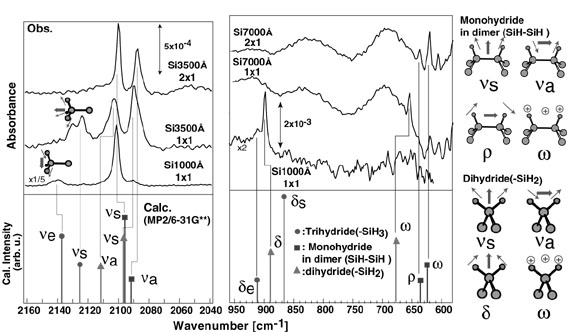
Physical Science Research Laboratory
*Materials Science Research Laboratory
Hydrogen (H) on a Si surface plays an important role in crystal growth such as CVD and has been applied recently to surface passivation and surfactant in heteroepitaxial growth. For the (111) substrate, where an atomically flat H-terminated surface can be easily prepared by wet chemical processes, the surface H has been investigated intensively using IR spectroscopy which is very sensitive to Si-H vibrations. For the practically important (001) substrate, however, even assignment of the signals in IR spectra has not been established because preparation of a flat surface is very difficult. We prepared well-ordered H on a Si(001) surface in UHV and observed IR spectra in vacuo. The Si substrate with a buried metal layer (BML) enabled the measurements of the bending vibration region where the traditional ATR method can not be applied[1]. Moreover, we analyzed the spectra based on ab initio molecular orbital (MO) calculations.
Figure compares the IR spectra observed under various conditions and the results of cluster calculations performed under MP2/6-31G** level, where electron correlation is included. Vibration modes of mono- and di-hydride (M,D) structures and directions of transition moments in each mode are also annotated schematically. The surface selection rule on the BML substrate surface[1] predicts that only modes vertical to the surface should be observed for relatively thin (e.g., 1000Ѓ) Si overlayers, while mainly lateral modes should be detected at a significant intensity for relatively thick ( e.g., 3500Ѓ in the Si-H stretching region and 7000Ѓ in the bending region) overlayers. Considering this selection rule we can see fair agreement between the observed IR signals and the calculated energy of normal modes in the stretching and bending vibration regions. The results for trihydride (T) mean that bonds between T and Si are directed parallel to the surface and suggest that T is formed at defect sites such as surface steps. Moreover, we can clearly observe a surface reaction in which the initial phase of a mixture of M+D+T changes to a phase composed solely of M. These results show that IR spectroscopy combined with the MO calculation becomes a more powerful probe of chemical environments on semiconductor surfaces.
[1] Y. Kobayashi et al., J. Vac. Sci. Technol. A14, 2263(1996), Surf. Sci. 368, 102(1996).

Fig: Comparison between typical IR reflection spectra observed from a H/Si(001) surface and the results of MO calculations where frequencies are scaled in the factor of 0.918.
Go back to 1996 Annual Report Index.
Go back to Ogino Group Home Page.
Yoshihiro Kobayashi / bigkoba@will.brl.ntt.co.jp